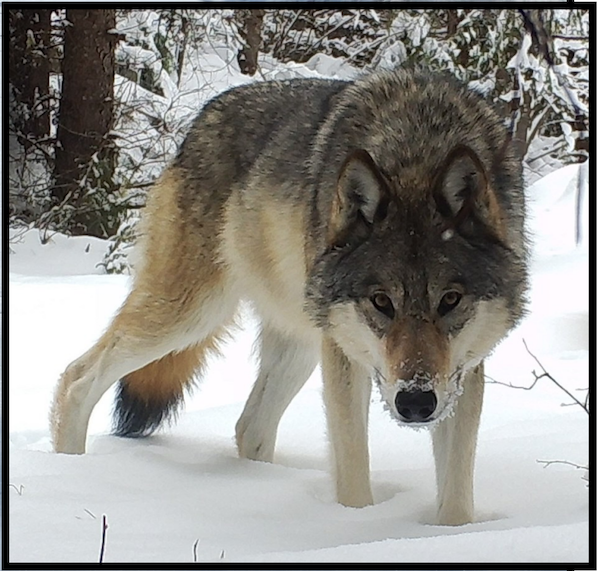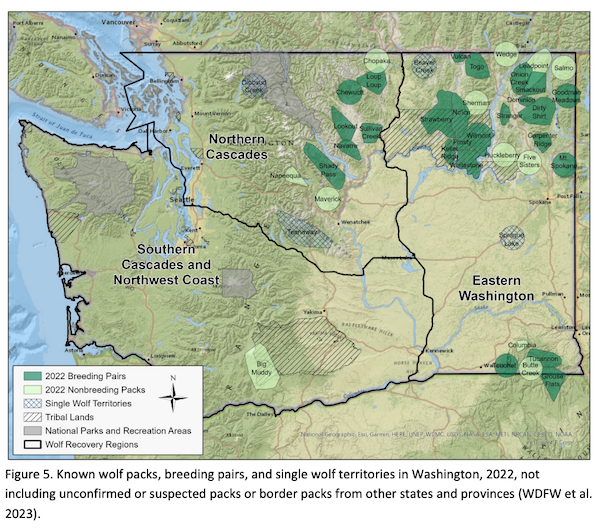
WDFW Proposes Downlisting Wolves To Sensitive But Still Protected
Washington wolves have “far exceeded” breeding pair numbers needed for delisting under the 2011 management plan, WDFW is acknowledging, but with packs slow to set up shop in the South Cascades, the agency is recommending only downlisting them from state endangered to protected-sensitive status.

That’s the word from WDFW’s long-awaited draft periodic status review, or PSR, which was released today for public comment.
“This status reflects the significant progress toward recovery that Washington’s wolf population has made since the original state listing in 1980 but recognizes that wolves remain vulnerable in Western Washington and should continue to be managed for recovery within the state as a protected species. Continued population growth and range expansion will depend on the robustness of source populations in Eastern Washington (as well as neighboring states and provinces) and cooperative management to ensure sources of human-caused mortality do not impede recovery,” the 51-page document states.
If adopted as is, the new classification would continue to preclude state hunting of wolves for the foreseeable future.
Even as new population modeling shows there’s a greater than 99 percent chance of reaching recovery goals by 2030 in the agency’s Southwest Cascades and Northwest Coast Recovery Zone, which includes the Olympics and Willapa Hills, WDFW will stick with the Fish and Wildlife Commission-approved 12-year-old management plan‘s benchmark of at least four successful breeding pairs in each of its three wolf regions before considering removing them from the state ESA list.
“We believe that these targets are attainable through natural recolonization and ensure adequate distribution of reproducing wolves throughout the state. WDFW does not recommend delisting wolves at this time,” the PSR states.
Previously, it was estimated Washington wolves would reach regional population goals as early as 2021, but that was also based on Northern Rockies wolves because there were so few in the state at the time that model was run. While the Teanaway Pack was perched on the edge of busy I-90 and the Southern Cascades for a decade, it was either at a dead end for wolves or the rabid incestuousness of its breeders had some dampening effect, or other reasons entirely, on colonization of the mountains south of the interstate.
Last year’s year-end count did find a minimum of 216 wolves across the state, reflecting a 14th straight year of growth, and they occurred in 37 packs with 26 of those being successful breeding pairs.

Indeed, the PSR does acknowledge that successful breeding pair counts and duration goals – 15 in three straight years, or 18 in any single year – have been reached in the Eastern Washington and the Northern Cascades recovery regions, and how.
“It is worth noting that wolf population growth in Washington has largely occurred in the absence of federal protection as the majority (60-86% of packs 2011–2022, average 79%) of Washington wolf packs occur in the eastern third of Washington where wolves have not been federally protected since 2011,” it states.
It has also occurred with legal tribal harvest in Northeast Washington accounting for 36 percent of all documented mortalities in the state since 2008, 63 wolves.
The PSR shows that WDFW has removed 42 wolves, accounting for 24 percent of all known deaths, while 20 mortalities (11 percent) are attributed to poachers or are still under investigation, 15 (8 percent) were shot by people who feared for their safety, 14 (8 percent) died of natural causes), 9 (5 percent) due to unknown reasons, 7 (4 percent) were killed while in the act of chasing livestock or domestic animals, and 7 (4 percent) got run over by vehicles.
The issuance of the status review follows the squishing of a bill and budget proviso in the state legislature this past session that would have moved WDFW toward creating a process for wolves to be managed at the county level in areas of the state where they’re federally delisted and have met certain population goals.
As it stands, moving wolves from state endangered to protected–sensitive status would leapfrog the protected–threatened classification. The difference between threatened and sensitive boils down to a few words in the Washington Administrative Code:
“Threatened” means any wildlife species native to the state of Washington that is likely to become an endangered species within the foreseeable future throughout a significant portion of its range within the state without cooperative management or removal of threats.
“Sensitive” means any wildlife species native to the state of Washington that is vulnerable or declining and is likely to become endangered or threatened in a significant portion of its range within the state without cooperative management or removal of threats.
WAC 220-610-110
Washington’s wolves are on a one-way trajectory, and that is upwards, no matter how much preservationist groups want to paint them as “imperiled” or suggest at times the state’s population is stagnating or only growing slowly, for their own fundraising reasons.
It’s disappointing that WDFW isn’t going further with this PSR, but given the myriad wolf lawsuits it has faced, the fact out-of-country and in-state wolf fanatics appear to have the ear of the Governor’s Office, and the 2011 plan (plus WAG-based protocols) and its population goals being the management plan until that plan stops being the plan, this periodic check-in on Washington’s long-legged furry fangers at least shows another certifiable measure of progress towards the eventual delisting of a widely spread, generalist species that really doesn’t need the kid-glove treatment that myriad actually-in-trouble critters could use but here we are spending some more effort, money and time on them.
One thing that WDFW could do in the draft PSR is explain if and how wolf management vis-à-vis a documented at-risk ungulate population – deer, elk, moose – may change under its recommended downlisting. Right now, if there are at least four successful breeding pairs in the recovery region, “WDFW could consider moving of wolves, lethal control, or other control techniques in localized areas to reduce wolf abundance in the area occupied by the ungulate population.” Does that stay the same under sensitive? Is it liberalized in any way?
Public comment is being taken on the document through the end of the day August 16, 2023.
You can provide your thoughts at publicinput.com/psr-gray-wolf, by emailing psr-gray-wolf@PublicInput.com or leaving a voicemail at 855-925-2801 (enter 2573 when asked for the code).

